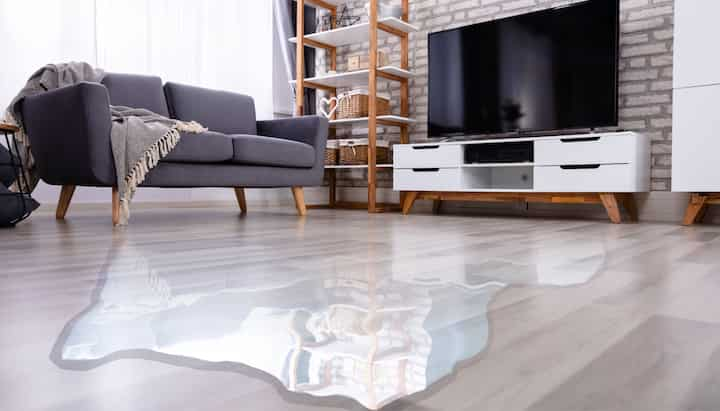Water damage is an increasingly common problem that can have a devastating impact on homes and families. Not only can it cause extensive structural damage, but it can also destroy personal belongings and cause financial hardship. Fortunately, there are some simple steps that homeowners can take to help prevent water damage in their home.

Identifying potential sources of damage
Water damage is a common and serious issue that can cause extensive property damage and personal distress. Identifying potential sources of water damage is an essential step in preventing it from occurring.
The most common source of water damage is plumbing. Leaks in plumbing fixtures, such as sinks, toilets, washing machines, and showers, can often go unnoticed until they cause substantial water damage. Regularly inspecting pipes and fixtures for visible signs of wear is important to detect any issues before they become more serious.
Another common source of water damage is flooding caused by severe weather or natural disasters. Taking precautionary steps such as installing storm shutters and waterproofing basement walls can help reduce the likelihood of water damage from flooding. Additionally, maintaining gutters and downspouts to ensure the proper drainage of rainwater away from the home is essential for preventing potential flooding.
Inspecting plumbing and appliances
To prevent water damage, it is important to inspect plumbing and appliances on a regular basis. It is essential to check for any signs of corrosion, rust, or wear and tear that may indicate a potential problem. This can be done by visually inspecting the outside of the appliance or plumbing fixture, as well as checking the hoses and connections for any signs of leaking. Additionally, periodic maintenance should be performed on all plumbing and appliances to ensure they are functioning properly.
Maintaining your home’s exterior
The exterior of your home is an essential factor in preventing water damage. Maintaining these areas will help ensure that rainwater is properly diverted away from your property and that any unwanted moisture is blocked from entering your home. Here are some tips to maintain the exterior of your home:
Firstly, ensure that gutters, downspouts, and other drainage systems are regularly cleaned out of debris. This will prevent clogging and ensure that rainwater can move freely away from the foundation of your house. Additionally, inspect for cracks or holes in the gutters and replace worn or broken parts as necessary.
Another important factor to consider is keeping trees and shrubs trimmed back from your home’s foundation. Overgrown vegetation can easily trap moisture against the side of a house and cause water damage over time. Furthermore, inspect for signs of settling due to erosion, such as dips in the terrain around your house or cracks in the foundation walls. If you notice any signs of settling, contact a professional right away to assess the situation and make repairs where necessary.
Regulating humidity levels in the home
Humidity levels in the home can have a substantial impact on water damage prevention. By maintaining proper humidity levels, it is possible to reduce the risk of Water Damage. To do so, an effective dehumidification system is required. The most common type of dehumidifier is a mechanical dehumidifier that works by drawing air into the unit and then removing the moisture from it. This type of dehumidifier is usually the most cost-effective option and can be effective in controlling humidity levels in the home.
Another option for controlling humidity levels in the home is to use a desiccant dehumidifier. This type of dehumidifier works by absorbing moisture from the air using a specialized material such as silica gel or calcium chloride. Desiccant dehumidifiers are typically more expensive than mechanical models but can be very effective in controlling humidity levels in areas with high humidity or where mechanical units are not practical.
It is also possible to control humidity levels naturally by making adjustments to ventilation and insulation. Proper ventilation helps remove excess moisture from indoor air while insulation traps heat inside, preventing warm air from entering and cooling down too quickly. Additionally, outdoor plants can help regulate indoor humidity levels by releasing moisture into the surrounding environment during photosynthesis.
Taking immediate action in the event of a leak
When a leak is noticed, taking immediate action is essential to prevent further damage. The first step is to turn off the water supply in order to stop any further leaks. It is also important to assess the situation and determine the extent of the damage caused by the leak. If necessary, it may be wise to call a professional for help with repairs and cleanup.
In some cases, simply finding and stopping the source of the leak will be enough to limit water damage. However, if water has seeped into walls or flooring, additional steps must be taken in order to ensure that mold does not begin to form. This can include removing wet carpets and furniture, drying out wet areas as soon as possible, and using fans and dehumidifiers if necessary.
In addition, it may also be helpful to inspect other parts of your home for signs of any potential leaks or moisture buildup that could lead to future problems. Taking preventative measures now can help avoid costly repairs down the road due to water damage. Keeping an eye on plumbing fixtures and checking for signs of wear can help protect your home from future issues with water damage.
By identifying potential sources of damage, inspecting plumbing and appliances, maintaining the home’s exterior, regulating humidity levels in the home, and taking immediate action in the event of a leak, one can significantly reduce the chances of experiencing water damage.
